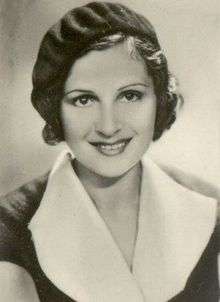Nora Gregor
Nora Gregor (3 February 1901 – 20 January 1949) was an Austrian stage and film actress.
Nora Gregor | |
|---|---|
 Nora Gregor in 1932 | |
| Born | Eleonora Hermina Gregor 3 February 1901 |
| Died | 20 January 1949 (aged 47) |
| Years active | 1920–1945 |
| Spouse(s) | Mitja Nikisch (ca. 1925 – ca. 1934) Ernst Ruediger, Prince von Starhemberg (1937–1949) |
Biography
She was born Eleonora Hermina Gregor in Görz, a town which then belonged to Austria-Hungary but is now part of Italy, to Austrian parents.[1][2]
Her first husband was Mitja Nikisch, a pianist and son of celebrated orchestral conductor Arthur Nikisch. They divorced circa 1934.
In the mid-1930s, Gregor became the mistress of the married vice chancellor of Austria, the Austro-fascist, nationalist politician Prince Ernst Ruediger von Starhemberg, with whom she had a son, Heinrich (1934–1997).[3] On 2 December 1937, five days after the prince's marriage to his first wife (the former Countess Marie-Elisabeth von Salm-Reifferscheidt-Raitz) was annulled, he and Gregor wed in Vienna.
In 1938, the Starhembergs emigrated to France through Switzerland, and her husband joined the Free French forces; cut off from their money and 80 family estates, they were supported for a period by Starhemberg's close friend Friedrich Mandl, the Austrian armaments magnate. In 1942, the Starhembergs moved to Argentina where they lived under humble circumstances. She was depressed by her exile to South America, and many sources claim her early death in Viña del Mar, Chile was a suicide.[4] However, her biographer Hans Kitzmüller calls a suicide unlikely and notes that her death was probably from natural causes.[5]
Career
Gregor entered films in the early 1920s. She worked briefly in Hollywood during the early sound era, appearing in the foreign-language versions of films such as The Trial of Mary Dugan (1929) and His Glorious Night (1929). She was considered to be one of Austria's more popular film stars during this time, and she appeared as a stage actress at the famous Burgtheater.[6]
During her French exile, Gregor played her most famous screen role as Christine de la Chesnaye in Jean Renoir's 1939 film La Règle du Jeu. Her last appearance was in the 1945 Chilean film La Fruta mordida.
Filmography
| Year | Title | Role | Notes |
|---|---|---|---|
| 1920 | Gefesselt | ||
| 1920 | Wie Satan starb | ||
| 1921 | The Grinning Face | Herzogin Josiane | |
| 1921 | Die Schauspielerin des Kaisers | ||
| 1922 | The Venus | Yvonne | |
| 1922 | Meriota the Dancer | Lukrezia Borgia | |
| 1922 | The Daughter of the Brigadier | ||
| 1922 | The Separating Bridge | ||
| 1922 | Der Mann, der das Lachen verlernte | ||
| 1923 | Irrlichter der Tiefe | ||
| 1923 | The Little Sin | ||
| 1924 | Modern Vices | ||
| 1924 | Mikaël | Fürstin Lucia Zamikoff | |
| 1925 | The Man Who Sold Himself | Daisy Bracca | |
| 1925 | The Girl with a Patron | Revuestar Orina Norowna | |
| 1926 | The Fiddler of Florence | Renées Stiefmutter | |
| 1927 | Eheskandal im Hause Fromont jun. und Risler sen. | Claire | |
| 1930 | Olympia | Olympia | |
| 1931 | Mordprozeß Mary Dugan | Mary Dugan | |
| 1931 | That's All That Matters | Renée Roettlinck | |
| 1931 | Wir schalten um auf Hollywood | Himself | |
| 1932 | But the Flesh Is Weak | Mrs. Rosine Brown | |
| 1933 | What Women Dream | Rina Korff | |
| 1933 | Abenteuer am Lido | Evelyn Norman | |
| 1939 | La règle du jeu | Christine de la Cheyniest | |
| 1945 | La Fruta mordida | La mère | final film role |
Names and Styles
- 1901-ca. 1920: Fräulein Eleanora Gregor
- ca. 1925-ca.1934: Frau Mitja Nikisch (privately), Fräulein Nora Gregor (professionally)
- ca. 1934-1937: Fräulein Nora Gregor (professionally)
- 1937-1949: Her Most Serene Highness Princess von Starhemberg (privately; see Austrian nobility and Adelsaufhebungsgesetz), Fräulein Nora Gregor (professionally)
References
- http://www.cineartistes.com/fiche-Nora%2BGregor.html
- Alexander Waugh, "The House of Wittgenstein", Random House, 2009, page 201
- Born Heinrich Ruediger Gregor in Switzerland and legally named his father's heir in 1937 as Prince Heinrich von Starhemberg, the couple's only child was an actor, novelist, and playwright, professionally known as Heinrich Gregor, Henry Gregor, and Heinrich von Starhemberg. See http://www.time.com/time/magazine/article/0,9171,758568,00.html
- Kinn, Gail; Piazza, Jim (2008). "Rules of the Game". The Greatest Movies Ever. Black Dog Publishing. p. 156. ISBN 978-1-57912-782-4. Retrieved November 22, 2009.
- http://orf.at/stories/2265969/2265970/
- http://orf.at/stories/2265969/2265970/
External links
| Wikimedia Commons has media related to Nora Gregor. |